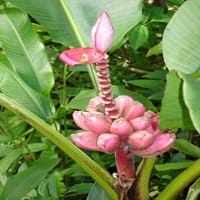Life Span
Perennial
Perennial
Type
Vegetable
Tender Perennial
Origin
Hybrid origin, Mexico, Central America, South America
India
Types
Bigleaf hydrangea, Hortensia, Smooth hydrangea, Oakleaf hydrangea, Annabelle
Scarlet banana, Fe'i bananas
Number of Varieties
Not Available
Habitat
Forest edges, Hillside, Woods
tropical environments, Tropical regions
USDA Hardiness Zone
11-15
7-10
AHS Heat Zone
12*1
Not Available
Sunset Zone
21,22
H1, H2, 11, 12, 13, 14, 15, 16, 17, 18, 19, 20, 21, 22, 23, 24
Habit
Vining/Climbing
Clump-Forming
Flower Color
Yellow
White, Yellow, Violet
Flower Color Modifier
Bicolor
Bicolor
Fruit Color
Red
Pink, Violet
Leaf Color in Spring
Green, Dark Green
Green
Leaf Color in Summer
Green, Dark Green
Green, Dark Green
Leaf Color in Fall
Green, Dark Green
Dark Green
Leaf Color in Winter
Green, Dark Green
Light Green
Leaf Shape
Oblovate
Arrowhead
Plant Season
Spring, Summer, Fall
Spring, Summer, Fall, Winter
Sunlight
Full Sun
Full Sun, Partial Sun
Type of Soil
Loam, Sand
Clay, Loam, Sand, Well drained
The pH of Soil
Neutral
Acidic, Neutral
Soil Drainage
Well drained
Well drained
Bloom Time
Indeterminate
Indeterminate
Tolerances
Drought
Drought
Where to Plant?
Container, Ground
Ground
How to Plant?
Seedlings, Stem Planting
Seedlings, Transplanting
Plant Maintenance
Medium
Medium
Watering Requirements
Not Available
Needs watering once a week, occasional watering once established, Requires watering in the growing season
In Summer
Average Water
Lots of watering
In Spring
Moderate
Moderate
In Winter
Average Water
Average Water
Soil pH
Neutral
Acidic, Neutral
Soil Type
Loam, Sand
Clay, Loam, Sand
Soil Drainage Capacity
Well drained
Well drained
Sun Exposure
Full Sun
Full Sun, Partial Sun
Pruning
Remove damaged leaves, Remove dead branches, Remove dead leaves
Remove damaged leaves, Remove dead branches, Remove dead leaves
Fertilizers
All-Purpose Liquid Fertilizer
Apply 8-10-8 amounts
Pests and Diseases
Red blotch
Red blotch
Plant Tolerance
Drought
Drought
Flower Petal Number
Single
Single
Fragrant Bark/Stem
Yes
No
Foliage Texture
Medium
Bold
Foliage Sheen
Matte
Glossy
Evergreen
Semi-Evergreen
No
Attracts
Bees, Flies
Insects, Spider Mites
Allergy
Chest tightness, Diarrhea, Dizziness, Nausea, Vomiting
Itchiness, Rash
Aesthetic Uses
Not Available
Not Used For Aesthetic Purpose
Beauty Benefits
Not Available
Good for skin, Skin cleanser
Edible Uses
Not Available
Yes
Environmental Uses
Air purification
Air purification, Food for birds
Medicinal Uses
Fever, Kidney problems, Urinary tract problems
Heals minor burns
Part of Plant Used
Flowers, Root
Fruits, Root
Other Uses
Not Available
Used As Food, Used as Ornamental plant, Used for its medicinal properties, Used in salads
Used As Indoor Plant
Not Available
No
Used As Outdoor Plant
Yes
Yes
Garden Design
Edible, Herb / Vegetable
Bedding Plant, Container, Feature Plant, Foundation, Mixed Border, Tropical
Botanical Name
LYCOPERSICON esculentum var. cerasiforme 'Juliet'
MUSA velutina
Common Name
Juliet Tomato
Banana, Hairy Banana, Pink Banana
In Hindi
Hydrangea
गुलाबी केले
In German
Hortensie
rosa Banana
In French
Hortensia
rose Banana
In Spanish
Hortensia
Pink plátano
In Greek
υδραγεία
ροζ Μπανάνα
In Portuguese
Hortênsia
Banana -de-rosa
In Polish
Hortensja
różowy Banana
In Latin
Hibiscus
Pink Banana
Phylum
Not Available
Vascular plant
Class
Not Available
Liliopsida
Order
Not Available
Zingiberales
Family
Solanaceae
Musaceae
Genus
Not Available
Banana
Clade
Not Available
Angiosperms, Commelinids, Monocots
Tribe
Not Available
Not Available
Subfamily
Not Available
Not Available
Number of Species
Not Available
Properties of Juliet Tomato and Pink Banana
Wondering what are the properties of Juliet Tomato and Pink Banana? We provide you with everything About Juliet Tomato and Pink Banana. Juliet Tomato doesn't have thorns and Pink Banana doesn't have thorns. Also Juliet Tomato does not have fragrant flowers. Juliet Tomato has allergic reactions like Chest tightness, Diarrhea, Dizziness, Nausea and Vomiting and Pink Banana has allergic reactions like Chest tightness, Diarrhea, Dizziness, Nausea and Vomiting. Compare all the properties and characteristics of these two plants. Find out which of these plant can be used as indoor plant. If you are interested to decorate your house and garden, find out aesthetic uses, compare them and select the plant which will beautify your surrounding. Along with beautification, try comparing medicinal and edible uses of Juliet Tomato and Pink Banana and you can choose the plant having best and most benefits.
Season and Care of Juliet Tomato and Pink Banana
Season and care of Juliet Tomato and Pink Banana is important to know. While considering everything about Juliet Tomato and Pink Banana Care, growing season is an essential factor. Juliet Tomato season is Spring, Summer and Fall and Pink Banana season is Spring, Summer and Fall. The type of soil for Juliet Tomato is Loam, Sand and for Pink Banana is Clay, Loam, Sand, Well drained while the PH of soil for Juliet Tomato is Neutral and for Pink Banana is Acidic, Neutral.
Juliet Tomato and Pink Banana Physical Information
Juliet Tomato and Pink Banana physical information is very important for comparison. Juliet Tomato height is 15.00 cm and width 60.00 cm whereas Pink Banana height is 365.76 cm and width 243.84 cm. The color specification of Juliet Tomato and Pink Banana are as follows:
Juliet Tomato flower color: Yellow
Juliet Tomato leaf color: Green and Dark Green
Pink Banana flower color: White, Yellow and Violet
- Pink Banana leaf color: Green
Care of Juliet Tomato and Pink Banana
Care of Juliet Tomato and Pink Banana include pruning, fertilizers, watering etc. Juliet Tomato pruning is done Remove damaged leaves, Remove dead branches and Remove dead leaves and Pink Banana pruning is done Remove damaged leaves, Remove dead branches and Remove dead leaves. In summer Juliet Tomato needs Average Water and in winter, it needs Average Water. Whereas, in summer Pink Banana needs Lots of watering and in winter, it needs Average Water.

